MSI Megabook S271: a Look at AMD's Turion X2
by Jarred Walton on October 16, 2006 12:05 AM EST- Posted in
- Laptops
General System Performance
We'll begin with a look at general system performance, using SYSmark 2004 and Winstones 2004 in order to analyze office and content creation performance. Both benchmark suites include a large variety of applications, from those that show no benefit whatsoever for multiple processor cores to applications that can fully utilize dual core processors. First let's took a look at the overall SYSmark 2004 performance results.
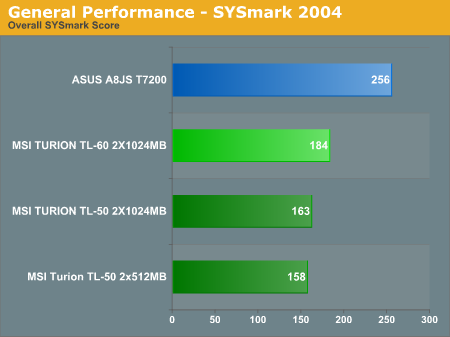
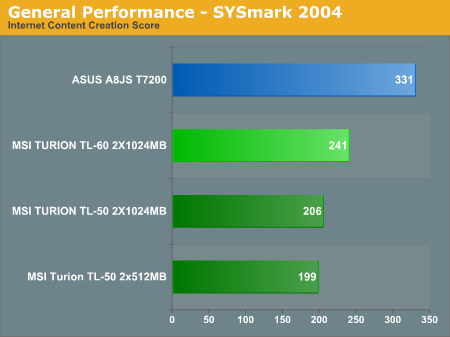
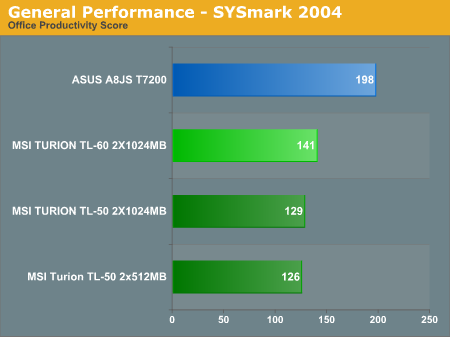
In overall performance, the Core 2 Duo equipped ASUS notebook simply puts the MSI notebook to shame. The approximately equal configurations sporting 2.0 GHz processors and 2 GB of memory still show ASUS leading by nearly 40% on average. If you're running tasks that demand maximum performance, it's pretty clear that the fastest Turion X2 processor currently available has no chance of keeping up with Core 2 Duo. That's not too surprising, considering the big brother desktop variants are in a similar situation, only with higher clock speeds. Having more memory (2GB versus 1GB) also improves performance slightly in SYSmark, though only by 2-4%. Most of the benchmark suites are several years old now, unfortunately, so they may not represent the most accurate picture of modern application performance and memory use. As we mentioned earlier, trying to work with only 512MB of RAM felt painfully slow.
SYSmark tends to be a bit more stressful on systems than other productivity benchmarks, and as such represents something of a worst-case scenario for office/business use. Let's take a look at Winstones 2004 performance to see the picture changes at all.

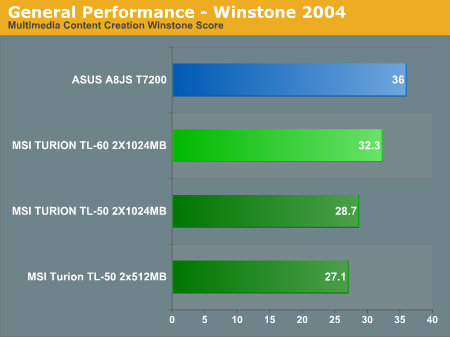
In the Business Winstones performance test, the ASUS lead drops to 32%, while the Content Creation margin is reduced to a mere 11%. Depending on the tasks and applications you are using, the difference between Turion X2 and Core 2 Duo notebooks can range from a relatively small performance advantage up through significantly better performance. Taking a broader view of the general application performance, however, an equivalent clock speed Core 2 Duo processor is clearly faster in every situation. Remember that these are benchmarks where the graphics processor really isn't doing much, and even the hard drive doesn't have a huge impact on performance. We would still like to compare equivalently equipped systems, but at best it looks like Turion X2 might be able to match mobile Core 2 Duo performance.
For those that would like to see individual results from the remaining SYSmark 2004 tests, you can see those below.
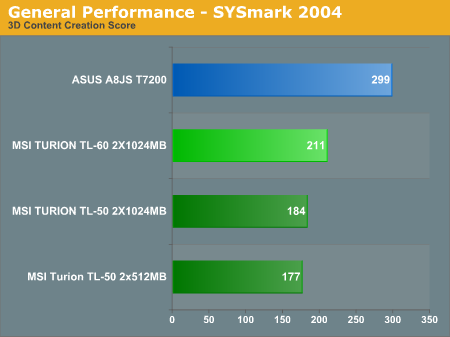
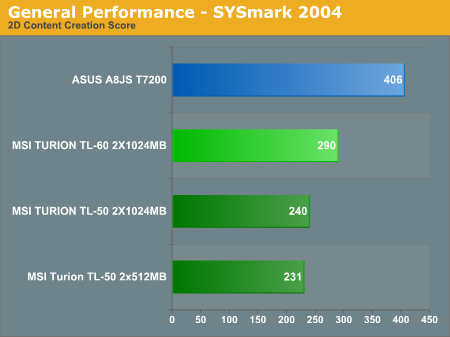
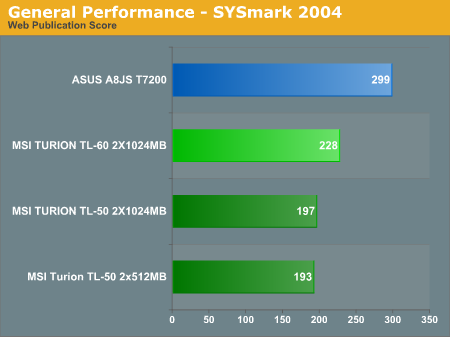

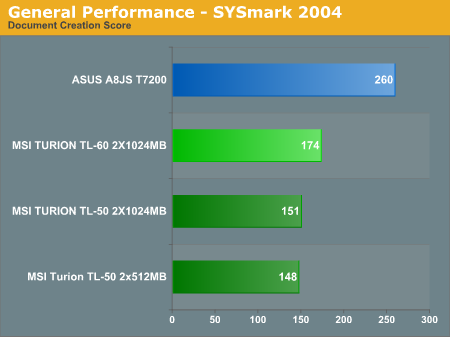
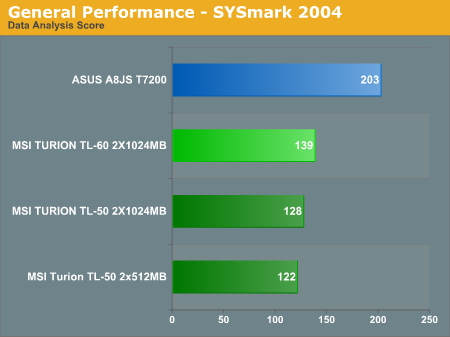
As we've already stated, Core 2 Duo swept all of these benchmarks, even when drilling down to the individual results.
We'll begin with a look at general system performance, using SYSmark 2004 and Winstones 2004 in order to analyze office and content creation performance. Both benchmark suites include a large variety of applications, from those that show no benefit whatsoever for multiple processor cores to applications that can fully utilize dual core processors. First let's took a look at the overall SYSmark 2004 performance results.



In overall performance, the Core 2 Duo equipped ASUS notebook simply puts the MSI notebook to shame. The approximately equal configurations sporting 2.0 GHz processors and 2 GB of memory still show ASUS leading by nearly 40% on average. If you're running tasks that demand maximum performance, it's pretty clear that the fastest Turion X2 processor currently available has no chance of keeping up with Core 2 Duo. That's not too surprising, considering the big brother desktop variants are in a similar situation, only with higher clock speeds. Having more memory (2GB versus 1GB) also improves performance slightly in SYSmark, though only by 2-4%. Most of the benchmark suites are several years old now, unfortunately, so they may not represent the most accurate picture of modern application performance and memory use. As we mentioned earlier, trying to work with only 512MB of RAM felt painfully slow.
SYSmark tends to be a bit more stressful on systems than other productivity benchmarks, and as such represents something of a worst-case scenario for office/business use. Let's take a look at Winstones 2004 performance to see the picture changes at all.


In the Business Winstones performance test, the ASUS lead drops to 32%, while the Content Creation margin is reduced to a mere 11%. Depending on the tasks and applications you are using, the difference between Turion X2 and Core 2 Duo notebooks can range from a relatively small performance advantage up through significantly better performance. Taking a broader view of the general application performance, however, an equivalent clock speed Core 2 Duo processor is clearly faster in every situation. Remember that these are benchmarks where the graphics processor really isn't doing much, and even the hard drive doesn't have a huge impact on performance. We would still like to compare equivalently equipped systems, but at best it looks like Turion X2 might be able to match mobile Core 2 Duo performance.
For those that would like to see individual results from the remaining SYSmark 2004 tests, you can see those below.






As we've already stated, Core 2 Duo swept all of these benchmarks, even when drilling down to the individual results.










31 Comments
View All Comments
JarredWalton - Tuesday, October 17, 2006 - link
I don't have it any more, but it was a 1.66 GHz Core Duo with 512MB RAM and IGP and an 80GB 5400 RPM HDD I believe. So at that speed it was still using aroung 18-19W at idle with minimum display brightness. I'm trying to get the owner of that laptop to run some power tests for me (our old Kristopher Kubicki has one now).